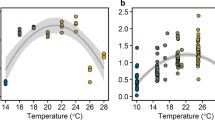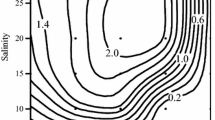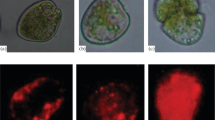Abstract
The effects of salinity (8 to 38‰) on the marine plankton diatom Thalassiosira rotula Meunier were investigated with respect to different temperature and light conditions. Two ecological aspects were examined separately: (1) the effect of various salinities, constant over a long period, was studied using well adapted cultures; (2) mixing processes were simulated by transferring cell chains from water of 33.9 or 20‰ S into lower salinities, as well as from 33.9 into 38‰ S. At 12° and 17°C, growth occurred at salinities from 12 to 38‰. In cold water (6°C), T. rotula did not grow below 16‰ S. Generation time was not influenced by salinities within the tolerance range if adapted cultures were grown under optimal illumination (1000 lux, light-dark cycle of 14:10 h; 12°C) or temperature (17°C; 2000 lux, light-dark cycle of 14:10 h). With increasing illumination or decreasing temperature, the other factors remaining constant, maximum growth rates were obtained with a salinity range of 20 to 32‰. Various salinities affected division rates most obviously if cultures were grown under continuous illumination; the optimum for cell division then ranged from 24 to 28‰ S only. Using adapted cultures again, the effect of different salinities on final cell yield is presumably more intense than their influence on generation time. T. rotula responded to sudden salinity changes only if transferred from water of 20‰ S into lower concentrations and from 33.9 into 38‰ S. Particularly at 12 and 38‰ S, growth rate and colony size (cells per chain) were reduced during the first few days. Increase of generation time and decrease of chain size occur coincidentally. The influence of different salinities on the occurrence of T. rotula in the sea is discussed in conjunction with experimental results on other ecological factors, and the present results are compared with the few available data obtained in nature by other authors. Accordingly, in the sea, a salinity range of 20 to 33‰ should prove optimal for T. rotula, 34 to 38‰ S would presumably represent still adequate conditions, while below 20‰ S T. rotula would probably rarely or never occur.
Similar content being viewed by others
Zitierte Literatur
Alderdice, D.F.: Factor combinations: responses of marine poikilotherms to environmental factors acting in concert. In: Marine ecology, Vol. I. Environmental factors, Pt 3. pp 1659–1722. Ed. by O. Kinne. London: Wiley-Interscience 1972
Allen, E.J.: On the culture of the plankton diatom Thalassiosira gravida Cleve, in artificial sea-water. J. mar. biol. Ass. U.K. 10, 417–439 (1914)
Braarud, T.: Salinity as an ecological factor in marine phytoplankton. Physiologia Pl. 4, 28–34 (1951)
Braarud, T.: Species distribution in marine phytoplankton. J. oceanogr. Soc. Japan 20th Anniversary Vol., 628–649 (1962)
Findlay, I.W.O.: Effects of external factors and cell size on the cell division rate of a marine diatom, Coscinodiscus pavillardii Forti. Int. Revue ges. Hydrobiol. 57, 523–533 (1972)
Fogg, G.E.: Algal cultures and phytoplankton ecology, 126 pp. Madison, Milwaukee & London: University of Wisconsin Press 1966
Gardiner, A.C.: Fluctuations in the number of cells per colony of the diatom, Asterionella formosa. Proc. Linn. Soc. Lond. 153, p. 160 (1941)
Guillard, R.R.L. and S. Myklestad: Osmotic and ionic requirements of the marine centric diatom Cyclotella nana. Helgoländer wiss. Meeresunters. 20, 104–110 (1970)
— and J.H. Ryther: Studies of marine planktonic diatoms. I. Cyclotella nana Hustedt, and Detonula confervacea (Cleve) Gran. Can. J. Microbiol. 8, 229–239 (1962)
Hulburt, E.M. and J. Rodman: Distribution of phytoplankton species with respect to salinity between the coast of southern New England and Bermuda. Limnol. Oceanogr. 8, 263–269 (1963)
Ignatiades, L. and T.J. Smayda: Autecological studies on the marine diatom Rhizosolenia fragilissima Bergon. I. The influence of light, temperature, and salinity. J. Phycol. 6, 332–339 (1970)
Kain, J.M. and G.E. Fogg: Studies on the growth of marine phytoplankton. I. Asterionella japonica Gran. J. mar. biol. Ass. U.K. 37, 397–413 (1958)
Kinne, O.: The effects of temperature and salinity on marine and brackish water animals. II. Salinity and temperature salinity combinations. Oceanogr. mar. Biol. A. Rev. 2, 281–339 (1964)
— Temperature: animals-invertebrates. In: Marine ecology, Vol. I. Environmental factors, Pt 1. pp 407–514. Ed. by O. Kinne, London: Wiley-Interscience 1970
McLachlan, J.: The effect of salinity on growth and chlorophyll content in representative classes of unicellular marine algae. Can. J. Microbiol. 7, 399–406 (1961)
Odum, E.P.: Fundamentals of ecology, 546 pp. Philadelphia & London: W.B. Saunders Co. 1959
Schöne, H.K.: Untersuchungen zur ökologischen Bedeutung des Seegangs für das Plankton mit besonderer Berücksichtigung mariner Kieselalgen. Int. Revue ges. Hydrobiol. 55, 595–677 (1970)
—: Experimentelle Untersuchungen zur Ökologie der marinen Kieselalge Thalassiosira rotula. I. Temperatur und Licht. Mar. Biol. 13, 284–291 (1972)
Smayda, T.J.: Experimental observations on the influence of temperature, light, and salinity on cell division of the marine diatom, Detonula confervacea (Cleve) Gran. J. Phycol. 5, 150–157 (1969)
— and B.J. Boleyn: Experimental observations on the flotation of marine diatoms. I. Thalassiosira cf. nana, Thalassiosira rotula and Nitzschia seriata. Limnol. Oceanogr. 10, 499–509 (1965)
——: Experimental observations on the flotation of marine diatoms. II. Skeletonema costatum and Rhizosolenia setigera. Limnol. Oceanogr. 11, 18–34 (1966)
Stanley, S.O. and R.Y. Morita: Salinity effect on the maximal growth temperature of some bacteria isolated from marine environments. J. Bact. 95, 169–173 (1968)
Stosch, H.A. von und G. Drebes: Entwicklungsgeschichtliche Untersuchungen an zentrischen Diatomeen. IV. Die Planktondiatomee Stephanopyxis turris, ihre Behandlung und Entwicklungsgeschichte. Helgoländer wiss. Meeresunters. 11, 209–257 (1964)
Swift, E. 5th and W.R. Taylor: The effect of pH on the division rate of the coccolithophorid Cricosphaera elongata. J. Phycol. 2, 121–125 (1966)
Takano, H.: Diatom culture in artificial sea water — I. Experiments on five pelagic species. Bull. Tokai reg. Fish. Res. Lab. 37, 17–25 (1963)
Wood, B.J.B., P.B. Tett and A. Edwards: An introduction to the phytoplankton, primary production and relevant hydrography of Loch Etive. J. Ecol. 61, 569–585 (1973)
Author information
Authors and Affiliations
Additional information
Communicated by O. Kinne, Hamburg
Rights and permissions
About this article
Cite this article
Schöne, H.K. Experimentelle Untersuchungen zur Ökologie der marinen Kieselalge Thalassiosira rotula. II. Der Einfluß des Salzgehaltes. Mar. Biol. 27, 287–298 (1974). https://doi.org/10.1007/BF00394364
Accepted:
Issue Date:
DOI: https://doi.org/10.1007/BF00394364




